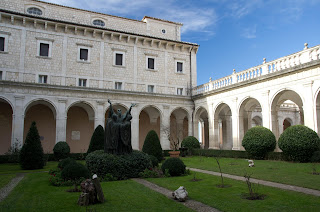On our drive from Sorrento to Rome, we decided to take a
side trip to Monte Cassino. About halfway between the two cities, the Abbey of Monte
Cassino sits high above its surroundings offering commanding views of the
countryside after a long and winding road to the top of the mount. This was our
second visit to a World War II battle site; this one has a more difficult story
than the easy landing at Pasteum and Salerno several months earlier.
 |
| St. Benedict |
The monastery was founded by St. Benedict in 529 on the
remains of an ancient Roman fortification as were so many Christian churches
and holy sites. In fact, the Temple of Apollo was still in use as a religious
site when Benedict arrived. Over the following years the abbey would be
destroyed several times both through wars and natural events. First it was the
Longebords in 577, then the Saracens in 883, then an earthquake in 1349. The
final destruction was by Allied bombers in 1944. Each time it was rebuilt to
its former glory although not all the art works would be saved.
 |
| The entrance cloister |
Benedict had already founded 12 communities for monks before
he moved to Monte Cassino, but he would spend the rest of his life atop this
hill. He would die and be buried at this beautiful spot and the abbey would
prosper as the years passed. Today the abbey features two cloisters. The
entrance cloister is a grassy park-like square with a statue of Benedict
donated by West German Chancellor Adenaur in 1952. The second cloister is the
entrance to the basilica cathedral. It is a more traditional cathedral
courtyard surrounded by Corinthian columns and statues.
 |
| The grand staircase leading up to the Basilica |
Bronze doors open into the ornate cathedral space. The white
and gold motif give the the building an open feeling that surpasses any church
we have visited. Built in a typical style with three naves and several chapels
on each side, the building is most impressive.
 |
| Bronze Doors |
The crypt is almost completely covered with mosaics and completes the beautiful building.
 |
| The Crypt |
Outside we were provided with great views of the countryside
and a Polish War Cemetery where over
1000 Polish soldiers are buried. Monte Cassino was the site of one of the most
important battles of the Italian campaign. The Allies had landed at Salerno and
Pasteum and expected to move north rather quickly. However, the rugged Italian terrain
and the great efforts by the German army slowed the effort considerably.
Eventually the Allies made another landing at Anzio – another difficult landing
where the Germans fought a bitter albeit unsuccessful battle to stop the Allied
advance.
Monte Cassino was the last major obstacle on the way to
Rome. The hills gave the Germans a decided advantage in their defensive
efforts. The separate armies had agreed to keep the Abbey off limits and
fortunately they sent many of the most valuable art words to Rome for
safe-keeping.
 |
| Grapes grown by the Abbey |
 |
| The first snow we have seen. There will be more. |
However, a misread memo led the Allies to believe that the
Germans were, in fact, using the Abbey as a base and in three short hours on February
15, 1944, they reduced the Abbey to a pile of rubble. The only people kills
there were locals and monks who were using the Abbey as a place to be safe from
the war. It was only a few years ago that the US military finally admitted the
truth in their documentation of the battle. The irony of the bombing was that
by reducing the Abbey to rubble, they provided the German army with an even
better defensive position well protected by the elevation and the rocky remains
of the Abbey.
 |
| Photos of the destruction |
By the mid-1950s, the Abbey had been rebuilt according to
the old plans and we were able to visit it in its glory. While the museum was
not open we were able to see most of what it had to offer. We have found it
interesting that there is little memorializing of the war in Italy. Here the
big effort is the Polish War Cemetery. At Salerno and Pasteum we found no
memorials at all. This is a huge contrast to what is at the beaches of
Normandy, which we have not visited.
 |
| More than 1000 Polish soldiers buried here |









No comments:
Post a Comment